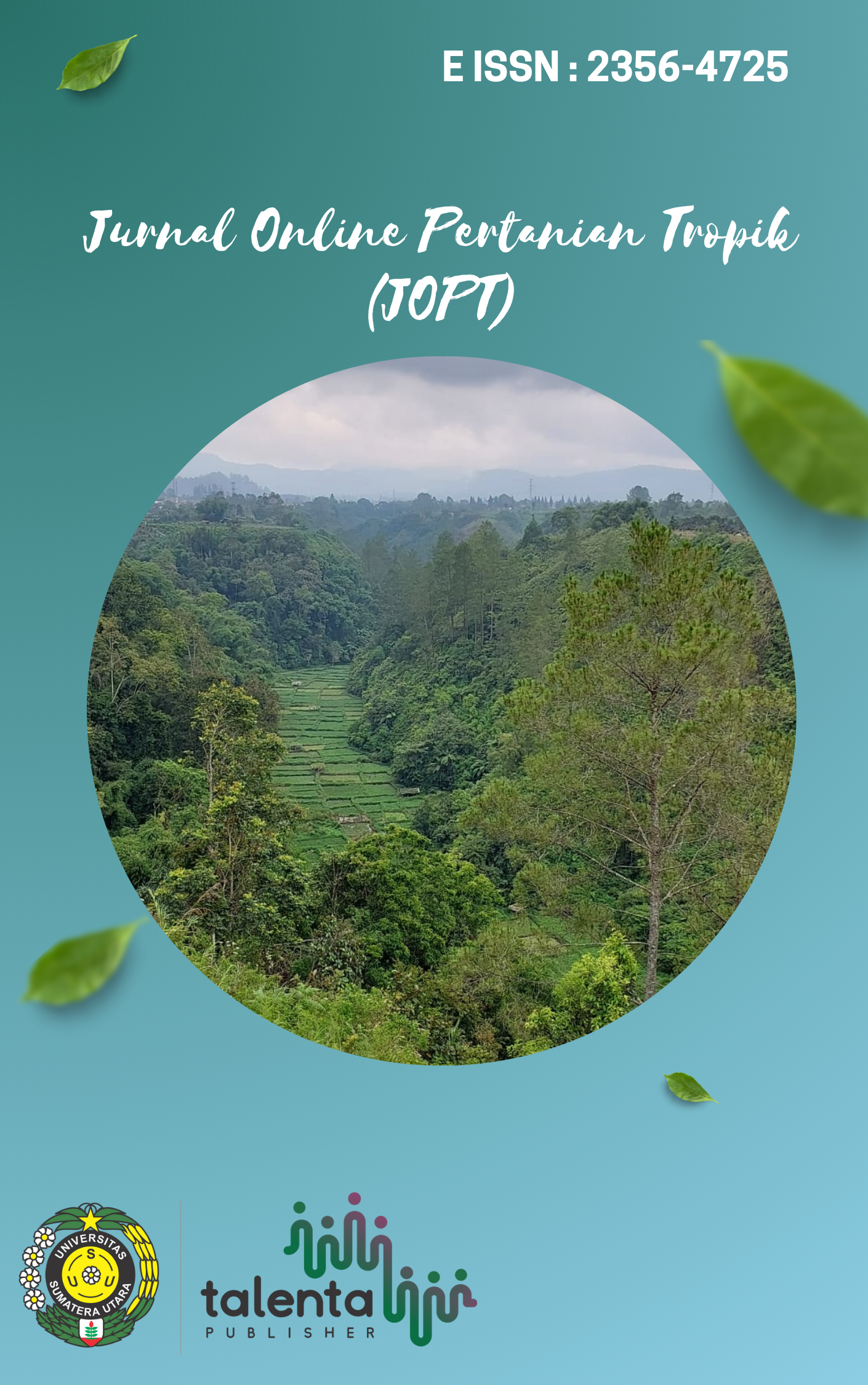Test Some Concentration of Bacillus subtilis to Increase the Resistance of Tomato Plants to Xanthomonas campestris pv. vesicatoria
Uji Beberapa Konsentrasi Bacillus subtilis untuk Meningkatkan Ketahanan Tanaman Tomat terhadap Xanthomonas campestris pv. vesicatoria
DOI:
https://doi.org/10.32734/jpt.v10i1.9727Keywords:
tomato, concentration, Bacillus subtilis, Xanthomonas campestris pv. vesicatoriaAbstract
The aim of this study is to know the effect of several concentrations of Bacillus subtilis and to obtain a concentration capable of inducing tomatoes from attack by Xanthomonas campestris pv. vesicatoria. This study was conducted experimentally using a completely randomized design (RAL) with 5 treatments and 4 replications. The treatment used was the concentration of Bacillus subtilis which consisted of B0 = no use of Bacillus subtilis, B1 = concentration of Bacillus subtilis 106 cells.ml-1, B2 = concentration of Bacillus subtilis 107 cells.ml-1, B3 = concentration of Bacillus subtilis 108 cells.ml-1, B4 = concentration of Bacillus subtilis 109 cells.ml-1. The parameters observed were the number of colonies of Bacillus subtilis in the growth medium, the concentration of salicylic acid content, disease intensity, plant height, stem diameter, and weight of fruit. The results showed that the concentration of Bacillus subtilis in each treatment was able to induce tomato plant resistance to Xanthomonas campestris pv. vesicatoria and gave significantly different results on the number of colonies on soil medium, the concentration of salicylic acid content, disease intensity, plant height, steam diameter, and weight of fruit.
Downloads
References
Badan Pusat Statistik dan Direktorat Jenderal Hortikulturan. (2020). Produksi Tomat Nasional per Provinsi 2017-2019.
Bustamam, H. (2006). Seleksi Mikroba Rizosfer Antagonis Terhadap Bakteri Ralstonia solanacearum Penyebab Penyakit Layu bakteri Pada Tanaman Jahe di Lahan Tertindas. Jurnal Ilmu-Ilmu Pertanian Indonesia. 8(1): 12-18.
Campbell, R. (1989). Biological Control of Microbial Plant Pathogens. University Press. Cambridge.
Djamaluddin. (1983). Pengaruh Pemberian Pupuk Fosfat, Pupuk Kandang Dan Kapur Terhadap Pertumbuhan Dan Produksi Tanaman Jagung (Zea mays L) Didaerah Transmigrasi BoneBone, luwu. Tesis. Institut Pertanian Bogor. Bogor.
Hersanti, & L Djaya. (2019). Kemampuan Trichoderma harzianum dalam formulasi serat karbon dan partikel silika nano (NPs) untuk menekan Phytophthora nicotianae. Semiloknas FKPTPI 2019
Ismawati, & Rida. (2012). Pengaruh Dosis Formula PGPR Asal Perakaran Bambu Terhadap Pertumbuhan Tanaman Tomat (Solanum lycopersicum L.). Jurnal Agroteknotropika. 1(1):9-12.
Istiqomah, & DE Kusumawati. (2018). Pemanfaatan Bacillus subtilis dan Pseudomonas fluorescens dalam pengendalian hayati Ralstonia solanacearum penyebab penyakit layu bakteri pada tomat. Jurnal Agroteknologi. 5(1): 1-12
Kumar, A., A. Prakash., & B.N. Johri. (2011). Bacillus as PGPR in Crop Ecosystem. Bacteria in Agrobiology; Crop Ecosystem. In: D. K. Maheshwari (eds). Bacteria in Agrobiology: Crop Ecosystems.pp 37-59.
Nurcahyani, E., Sumardi, I., Hadisutrisno, B., & Suharyanto, E. (2013). Penekanan perkembangan penyakit busuk batang vanili (Fusarium oxysporum f. sp. vanillae) melalui seleksi asam fusarat secara in vitro. Jurnal Hama Dan Penyakit Tumbuhan Tropika. 12(1): 12–22.
Rajendran, L. dan Samiyappan, R. (2008). Endophytic Bacillus species confer increased resistance in cotton against damping off disease caused by Rhizoctonia solani. Plant Pathology Journal. 7(1): 1–12.
Sarief E. S. (1985). Kesuburan dan Pemupukan Tanah Pertanian. Pustaka Buana. Bandung,
Siddiqui ZA. (2005). PGPR: Prospective Biocontrol Agents of Plant Pathogens. Netherlands: Springer.
Siddiqui, I.A & Shaukat, S. S. (2004). Systemic resistance in tomato induced by biocontrol bacteria against the root-knot nematode, Meloidogyne javanica is independent of salicylic acid production. Journal Phytopathology. 152, 48–54.
Sihotang, B. (2008). Tomat. Benidiktus Sihotang Site. http://www.google.com/tomat/Beni diktus Sihotang. Diakses tanggal 30 November 2020.
Sudarsono & A. Malik. (2006). Efektivitas Bakteri Antagonis yang Dikombinasikan dengan EM4 dan Bokashi Terhadap Penyakit Layu Bakteri pada Tanaman Kentang. Agros 8(1): 1-8.
Sufiyanti, A. (2019). Uji Biokontrol Bakteri Endofitik Micrococcus endophyticus G053 Dan Bacillus sp. terhadap Penyakit Busuk Lunak pada Planlet Kentang Varietas Medians. Skripsi (Tidak dipublikasikan) Fakultas Teknobiologi Universitas Sumbawa. Sumbawa Besar.
Suganda, T, E Yulia, F Widiantini, & Hersanti. (2016). Intensitas penyakit blas (Pyricularia oryzae Cav.) pada padi varietas ciherang di lokasi endemik dan pengaruhnya terhadap kehilangan hasil. Jurnal Agrikultura. 27(3):154-159
Tarabily, K., A. H. Nassar, & K. Sivasithamparam. (2003). Promotion of Plant Growth by An Auxin-Producing Isolate of The Yeast Williopsis Saturnus Endophytic In Maize Roots. The Sixth U. A. E University Research Conference. Hal. 60- 69.
Villareal, R.L. (1980). Tomato in the Tropics. Westview Press. Colorado.
Yazdani, M.A. Bahmanyar, H. Pirdashtidan & M.A. Esmaili. (2009). Effect of Phosphate Solubilization Microorganisms (PSM) and Plant Growth Promoting Rhizobacteria (PGPR) on Yield and Yield Components of Corn (Zea mays L.). Proceeding of World Academy of Science, Engineerring and Technology.Vol.3(7). Hal. 90-92.
Downloads
Published
How to Cite
Issue
Section
License
Copyright (c) 2023 Jurnal Pertanian Tropik

This work is licensed under a Creative Commons Attribution-ShareAlike 4.0 International License.






















